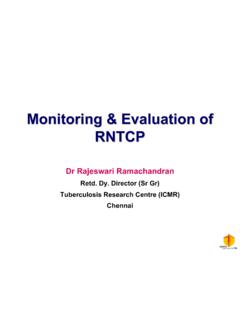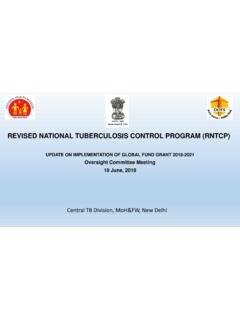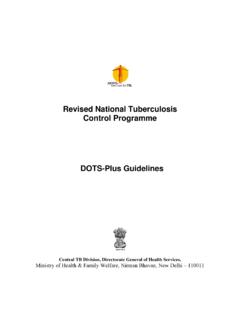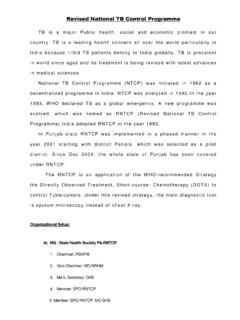Transcription of Treatment of childhood tuberculosis in India - TB Alliance
1 INT J TUBERC LUNG DIS 19(12):S43 S46Q2015 The FROM THE FIELDT reatment of childhood tuberculosis in IndiaS. Swaminathan,* K. S. Sachdeva *Department of Health Research, and Central TB Division, Ministry of Health and Family Welfare, Government ofIndia, New Delhi, IndiaSUMMARYWith a quarter of the global burden of tuberculosis (TB)occurring in India , children in this country are at highrisk of tuberculous infection and TB disease. India sRevised national tuberculosis control Programmeprovides free diagnosis and Treatment for children withTB using quality assured, weight-based individual drugboxes.
2 Guidelines have recently been revised , updatingboth the diagnostic algorithm and shifting to a dailyregimen with World Health Organization recommendeddosages using child-friendly, fixed-dose combinationpills. Active case finding is practised in households ofTB patients as well as among human immunodeficiencyvirus infected and malnourished children. More atten-tion needs to be paid to the provision of preventivetherapy for household contacts aged,6 years as well asto the detection of multidrug-resistant TB amongchildren. Case notification and the use of the Standardsof TB Care in India are being strengthened in the WORDS: India ; paediatric TB; first-line treatmentALMOST 40% of India s population is under 15years of age.
3 Although child tuberculosis (TB) in Indiais estimated to be approximately 10% of total adultincidence, only 6% of the total cases reported to theRevised national tuberculosis control Programme(RNTCP) are children, and this proportion hasremained constant for the last 9 years (Figure 1).1 Alarge proportion of children with TB are probablydiagnosed and managed by India s vast private sector:some proof of this is now available from Nikshay, thecase-based notification portal developed by theMinistry of Health and Family Welfare (Figure 2).2 Data from Sitamarhi District, Bihar State, show thatthe proportion of children diagnosed with TB ishigher in the private sector (17% vs.)
4 8% in RNTCP).However, as most private practitioners do not notifycases to the RNTCP, the overall burden of childhoodTB in the country is TB remains the most common form ofTB, although children suffer more from extra-pulmonary forms of TB than all other age records indicate that the numbers of youngchildren with TB meningitis and disseminated TBhave decreased over time, although the absolutenumbers are not insignificant. This is attributed to thewidespread use of the bacille Calmette-Gu erin (BCG)vaccine at birth, with coverage exceeding 90% inmost Indian line with global policy, the Indian governmenthas made significant efforts to prioritise thisvulnerable group in the RNTCP, with specificguidance for children included in the 2014 Standardsfor TB Care in India (STCI), as well as by settingtargets under the national Strategic Plan 2012 RNTCP has set guidelines for the diagnosisand Treatment of paediatric TB since inception.
5 Itsupplies quality-assured drugs in patient-wise pae-diatric boxes with a full course of Treatment byweight band. While the RNTCP uses an intermittent(thrice-weekly) regimen, most private paediatriciansuse a daily regimen. The STCI recommends a dailyregimen for both adults and children, and thegovernment is in the process of procuring fixed-dosecombinations (FDCs) using the World HealthOrganization (WHO) recommended dosing least two Indian manufacturers are in theprocess of obtaining regulatory approvals for are several forums addressing childhood TBinvolving representatives from the Indian Academyof Paediatrics (IAP; Mumbai, India ), such as theNational Technical Working Group (NTWG) onpaediatric TB.
6 Efforts are being made to integrateTB case finding and management into general childhealth activities, for example, the Integrated Man-agement of childhood and Neonatal Illness andReproductive and Child Health Programmes. TheRNTCP in India has a vertical structure down to thesub-district (block) level, beyond which it mergeswith the general health system (primary healthCorrespondence to: Soumya Swaminathan, Indian Council of Medical Research, Ansari Nagar, New Delhi 110 029, : ( 91) 11 2658 8204, Fax: ( 91) 11 2658 8662. e-mail: submitted 13 July 2015. Final version accepted 19 August physicians, pharmacists and village healthnurses).
7 ADDRESSING KEY ISSUES IN CHILDHOODTUBERCULOSIS1) Integration of TB services with the general healthsystem: the general health system is responsible fortreatment delivery, BCG immunisation and con-tact tracing, and refers child cases to the efforts are needed to sensitise communityhealth care providers and involve them in casefinding and Treatment monitoring. The govern-ment is considering a proposal to involve privatepaediatricians in improving diagnostic services forchildren in peripheral government health centreswhere paediatricians may not be ) Training: the IAP and RNTCP have jointlydeveloped training modules for paediatricians onTB management, including, but not limited to,programmatic guidelines.
8 These modules cover alldiagnostic and Treatment aspects of pulmonary andextra-pulmonary TB. A comprehensive cascadingtraining plan was initiated in early 2015 with thesupport of TB Alliance . A national train-the-trainers workshop was held in April 2015; this willbe followed by regional and state-level ) Improving diagnosis: children have been priori-tised by the national policy for access to rapiddiagnostics; however, implementation is stillpatchy. For example, a pilot to accelerate accessto quality TB diagnosis for paediatric cases isbeing conducted in four major Indian cities Delhi, Chennai, Kolkata and Hyderabad withthe purpose of identifying key hospitals, privateclinics and paediatricians to engage and establish areferral network.
9 This initiative has been hugelysuccessful, 000 specimens with theXpertwMTB/RIF assay (Cepheid, Sunnyvale, CA,USA) in 6 months and children withFigure 1 Number and proportion (of all TB cases) of childhood TB, 2006 2 tuberculosis notification in the 0 15 years age groupis higher from the private sector: an example from SitamarhiDistrict, Bihar State (September 2012 August 2013) (Source:Nikshay Data).2 RNTCP revised national tuberculosis International Journal of tuberculosis and Lung Diseasebacteriologically confirmed TB,~10% of whomhad rifampicin ) Screening vulnerable/high-risk children: in somestates nutritional rehabilitation centres (NRCs)are used to screen malnourished children for immunodeficiency virus (HIV) infectedchildren attending government antiretroviral ther-apy centres are regularly screened for TB.
10 Coor-dination mechanisms and service linkages exist,with upfront molecular diagnosis offered tochildren in a limited number of facilities. Mostchildren diagnosed with TB undergo HIV ) Contact screening and chemoprophylaxis: contactscreening to identify additional cases within thehousehold has been implemented by the RNTCP since its inception. All children aged,6 years whoare contacts of a family member with active TB areto be screened for TB, and are given isoniazidchemoprophylaxis after active TB has been ruledout. However, coverage is less than evaluations conducted between 2012 and2014 noted that 35 70% of children aged,6years did not receive chemoprophylaxis, highlight-ing the need to prioritise this ) Treatment : patient-wise Treatment boxes for dif-ferent paediatric weight categories have been usedfor the past 15 years, with overall good treatmentsuccess rates.









